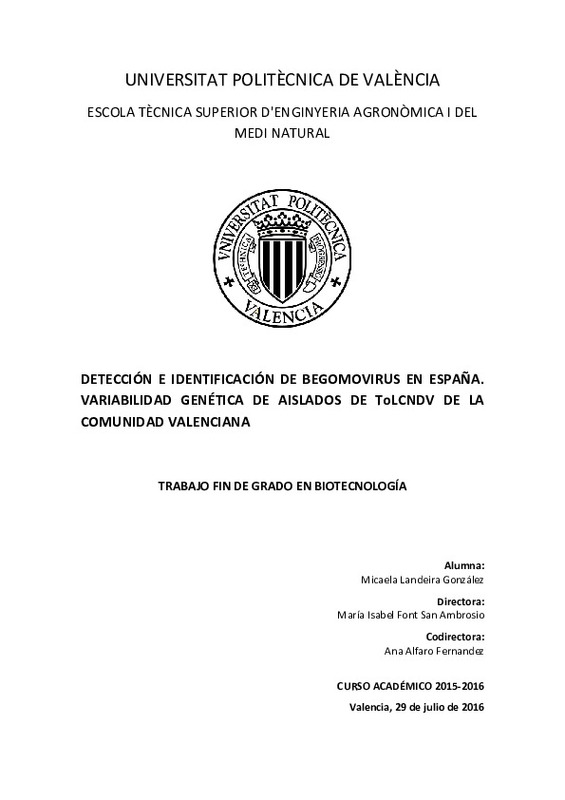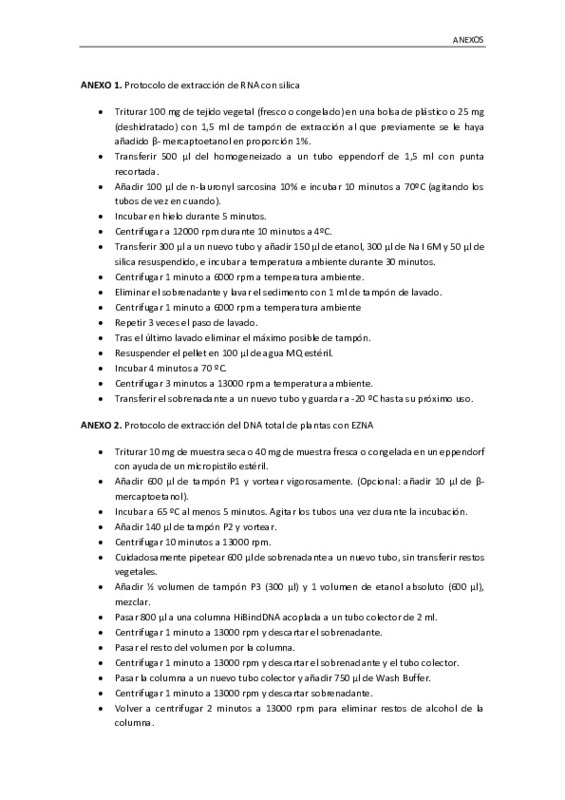JavaScript is disabled for your browser. Some features of this site may not work without it.
Buscar en RiuNet
Listar
Mi cuenta
Estadísticas
Ayuda RiuNet
Admin. UPV
Detección e identificación de Begomovirus en España. Variabilidad genética de aislados de ToLCNDV de la Comunidad Valenciana
Mostrar el registro sencillo del ítem
Ficheros en el ítem
| dc.contributor.advisor | Font San Ambrosio, Maria Isabel
|
es_ES |
| dc.contributor.advisor | Alfaro Fernández, Ana Olvido
|
es_ES |
| dc.contributor.author | Landeira González, Micaela
|
es_ES |
| dc.date.accessioned | 2016-09-30T07:23:07Z | |
| dc.date.available | 2016-09-30T07:23:07Z | |
| dc.date.created | 2016-09-15 | |
| dc.date.issued | 2016-09-30 | es_ES |
| dc.identifier.uri | http://hdl.handle.net/10251/70723 | |
| dc.description.abstract | [ES] El virus del rizado de tomate de Nueva Delhi (Tomato leaf curl New Delhi virus, ToLCNDV) pertenece al género Begomovirus englobado en la familia Geminiviridae. Recientemente, ToLCNDV fue detectado en 2013 en España en cultivos de cucurbitáceas, principalmente en calabacín, y en 2014 en tomate. Hasta entonces, otros Begomovirus como el virus del rizado amarillo del tomate (Tomato yellow leaf curl virus, TYLCV) y el virus del rizado amarillo del tomate especie Cerdeña (Tomato yellow leaf curl Sardinia virus, TYLCSV), se detectaban frecuentemente en los cultivos españoles de tomate. La infección de cultivos de cucurbitáceas y tomates por estos virus provoca grandes pérdidas en todo el mundo. Para controlar y tener la posibilidad de reducir los daños causado por estos virus, es importante disponer de técnicas de diagnóstico que permitan detectar dichos virus de manera sensible, rápida y con costes asumibles. Los objetivos del presente trabajo son: comparación de las técnicas de detección mediante PCR e hibridación molecular no radiactiva (NASH), comparación de métodos de extracción de ácidos nucleicos y estudio de la variabilidad de aislados de ToLCNDV muestreados en la Comunidad Valenciana. Para llevar a cabo el primer objetivo, se realizó la comparación de la hibridación molecular no radioactiva mediante dot-blot (NASH) con sondas específicas a ToLCNDV, TYLCV y TYLCSV con la PCR con cebadores específicos de ToLCNDV y de TYLCSV/TYLCV y PCR con dos parejas de cebadores degenerados que amplifican especies del género Begomovirus. Asimismo, se probaron dos métodos de extracción de ácidos nucleicos diferentes, EZNA Plant DNA Miniprep Kit (kit comercial para la extracción de DNA) y método de extracción de ácidos nucleicos totales mediante captura con silica. Por una parte, los resultados reflejaron que la PCR es la técnica que presenta mejores límites de detección, concretamente 100 veces mayor que NASH siempre que el protocolo de extracción sea el comercial EZNA. En el caso de la extracción mediante el método silica, el límite de detección es similar. Por tanto, existe buena correlación entre ellas, detectándose incluso algunas muestras positivas únicamente con NASH por la presencia de inhibidores de la PCR, lo que pone de manifiesto que la hibridación molecular es una buena alternativa para el diagnóstico rutinario de ToLCNDV. Asimismo se comprobó que el mejor método de extracción en el análisis por PCR es el DNA EZNA DNA Miniprep Kit para la extracción de DNA, mientras que para aplicar NASH se obtienen mejores resultados con extracción de ácidos nucleicos totales con silica. Para llevar a cabo la caracterización molecular de aislados virales valencianos de ToLCNDV, se seleccionaron tres aislados de distintos hospedantes, dos de diferentes especies de calabaza (Cucurbita maxima y C. moschata) y otro de calabacín (C. pepo) de diferentes zonas de Alicante. Se realizó la clonación del genoma completo de ToLCNDV diseñando cebadores degenerados dirigidos hacia zonas conservadas, que permitiesen la amplificación completa de cada componente del genoma (DNA-A y DNA-B). Una vez determinada la secuencia nucleotídica, se realizó un análisis filogenético mediante el modelo de Tamura-Nei. El DNA-B de los tres aislados se agrupó con el resto de aislados españoles, mientras que el único DNA-A que se agrupó junto al resto de aislados españoles es el del aislado procedente de C. moschata, los otros dos aislados se agruparon junto a otros aislados del virus procedentes de India y Pakistán. Tiempo previsto: 6 meses | es_ES |
| dc.description.abstract | [EN] Tomato leaf curl New Delhi virus (ToLCNDV) belongs to the genus Begomovirus, in the family Geminiviridae. ToLCNDV was detected recently in 2013 in Spain in cucurbits, mainly in zucchini, and in 2014 it was detected in tomatoes. Until then, other begomovirus such as yellow leaf curl virus tomato (Tomato yellow leaf curl virus TYLCV) and yellow leaf curl virus tomato species Sardinia (Tomato yellow leaf curl Sardinia virus, TYLCSV), were frequently detected in Spanish tomato crops. Infection of tomatoes and cucurbits by these viruses produces considerable economic losses worldwide. In order to control and reduce the damage caused by these viruses, it is important to have diagnostic techniques which allow for sensitive, fast and affordable detection. The objectives of this study were the comparison of detection techniques using PCR and nucleic acid spot hybridization (NASH), the comparison between different methods for extracting nucleic acids (EZNA Plant DNA commercial kit, from Omega Biotech, and silica capture method), and the study of variability of the ToLCNDV isolates of the Valencian Community. Results showed that the PCR is the technique obtained better detection limits, namely 100 times greater than NASH with the EZNA extraction protocol. In the case of extraction by the silica method, the detection limit is similar. Therefore, there is a good correlation between them, detecting even some positive samples only with NASH due to the presence of PCR inhibitors, which shows that the molecular hybridization is a good alternative for routine diagnosis of ToLCNDV. It was also shown that the best method of extraction of DNA for PCR analysis is the EZNA commercial kit, in contrast to the NASH method, where the best results are obtained with silica capture method. In order to perform the molecular characterization of valencian virus isolates of ToLCNDV, three isolates from different hosts, two pertaining to different species of pumpkin (Cucurbita maxima and C. moschata) and one to zucchini (C. pepo) from different areas of Alicante were selected. Whole genome sequencing of ToLCNDV was performed by designing degenerate primers directed to conserved areas, and then performing rolling circle amplification combined with PCR reactions, which allowed the complete amplification of each component of the genome (DNA-A and DNA-B). Once the nucleotide sequence was determined, a Blast analysis was carried out, which revealed a high nucleotide identity between the three isolates from the Valencian Community and the ToLCNDV Spanish isolates from the GenBank database, and a lower level of identity to the Indian and Pakistani isolates. A philogenetic analysis of the nucleotid sequence of DNA-B grouped together the sequenced isolates with the rest of the Spanish isolates, in contrast to the phylogenetic analysis of the nucleotid sequence of DNA-A, where the only isolate that was grouped together with the Spanish isolates was the C. maxima isolate, and the other two isolates where grouped together with the Indian and Pakistani isolates. Finally, the phylogenetic analysis of the proteins coded by the different open reading frames (ORF), showed the three isolates are to be grouped with the rest of the Spanish isolates, thus confirming the results of the Blast analysis. | es_ES |
| dc.format.extent | 66 | es_ES |
| dc.language | Español | es_ES |
| dc.publisher | Universitat Politècnica de València | es_ES |
| dc.rights | Reserva de todos los derechos | es_ES |
| dc.subject | DNA | es_ES |
| dc.subject | PCR | es_ES |
| dc.subject | Hibridación molecular NASH | es_ES |
| dc.subject | Tomate | es_ES |
| dc.subject | Cucurbitáceas. | es_ES |
| dc.subject | NASH molecular hybridization | es_ES |
| dc.subject | Tomato | es_ES |
| dc.subject | Curcurbits | es_ES |
| dc.subject.classification | PRODUCCION VEGETAL | es_ES |
| dc.subject.other | Grado en Biotecnología-Grau en Biotecnologia | es_ES |
| dc.title | Detección e identificación de Begomovirus en España. Variabilidad genética de aislados de ToLCNDV de la Comunidad Valenciana | es_ES |
| dc.type | Proyecto/Trabajo fin de carrera/grado | es_ES |
| dc.rights.accessRights | Abierto | es_ES |
| dc.contributor.affiliation | Universitat Politècnica de València. Departamento de Ecosistemas Agroforestales - Departament d'Ecosistemes Agroforestals | es_ES |
| dc.contributor.affiliation | Universitat Politècnica de València. Escuela Técnica Superior de Ingeniería Agronómica y del Medio Natural - Escola Tècnica Superior d'Enginyeria Agronòmica i del Medi Natural | es_ES |
| dc.description.bibliographicCitation | Landeira González, M. (2016). Detección e identificación de Begomovirus en España. Variabilidad genética de aislados de ToLCNDV de la Comunidad Valenciana. http://hdl.handle.net/10251/70723. | es_ES |
| dc.description.accrualMethod | TFGM | es_ES |
| dc.relation.pasarela | TFGM\48742 | es_ES |
Este ítem aparece en la(s) siguiente(s) colección(ones)
-
ETSIAMN - Trabajos académicos [3284]
Escuela Técnica Superior de Ingeniería Agronómica y del Medio Natural







